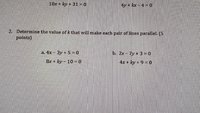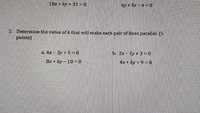You are using an out of date browser. It may not display this or other websites correctly.
You should upgrade or use an alternative browser.
You should upgrade or use an alternative browser.
Determine the value of k that will make each pair of lines parallel
- Thread starter kiel
- Start date
D
Deleted member 4993
Guest
What are the slopes of the lines in question?View attachment 24283 i am having trouble on how to do this, I solved value of k that will make perpendicular which is m¹ • m² but for this value of k that will make each pair parallel idk what solution to use if ill use m¹m² or wtvr. I just really need help on what to do/solution. Thank you!
What is the relationship between:
the slopes of the parallel lines?
View attachment 24283
HallsofIvy
Elite Member
- Joined
- Jan 27, 2012
- Messages
- 7,763
Did you notice that, in the first problem, the coefficient of x in the first equation is 4 and in the second equation it is 8. That coefficient has been multiplied by 2! The coefficient of y in the first equation is -3. In order to be parallel (have the same slope as Subhotosh Kahn suggested) that must be multiplied by 2 also.
In the second problem, the coefficient of x in the first equation is 2 and in the second equation it is 4. What has it been multiplied by? The coefficient of y in the first equation is -7. What must it be multiplied by to make the lines parallel?
In the second problem, the coefficient of x in the first equation is 2 and in the second equation it is 4. What has it been multiplied by? The coefficient of y in the first equation is -7. What must it be multiplied by to make the lines parallel?
Steven G
Elite Member
- Joined
- Dec 30, 2014
- Messages
- 14,383
Stop trying to do math by formulas. If two lines are parallel then they must have the same slope. So I will find the slope of both lines, set them equal to one another and solve for k.
What is written above is logical thinking. There was no formulas mentioned at all. True, in order to find the slopes you may need to use a formula but to think through how to do this problem did not involve any formulas.
What is written above is logical thinking. There was no formulas mentioned at all. True, in order to find the slopes you may need to use a formula but to think through how to do this problem did not involve any formulas.


